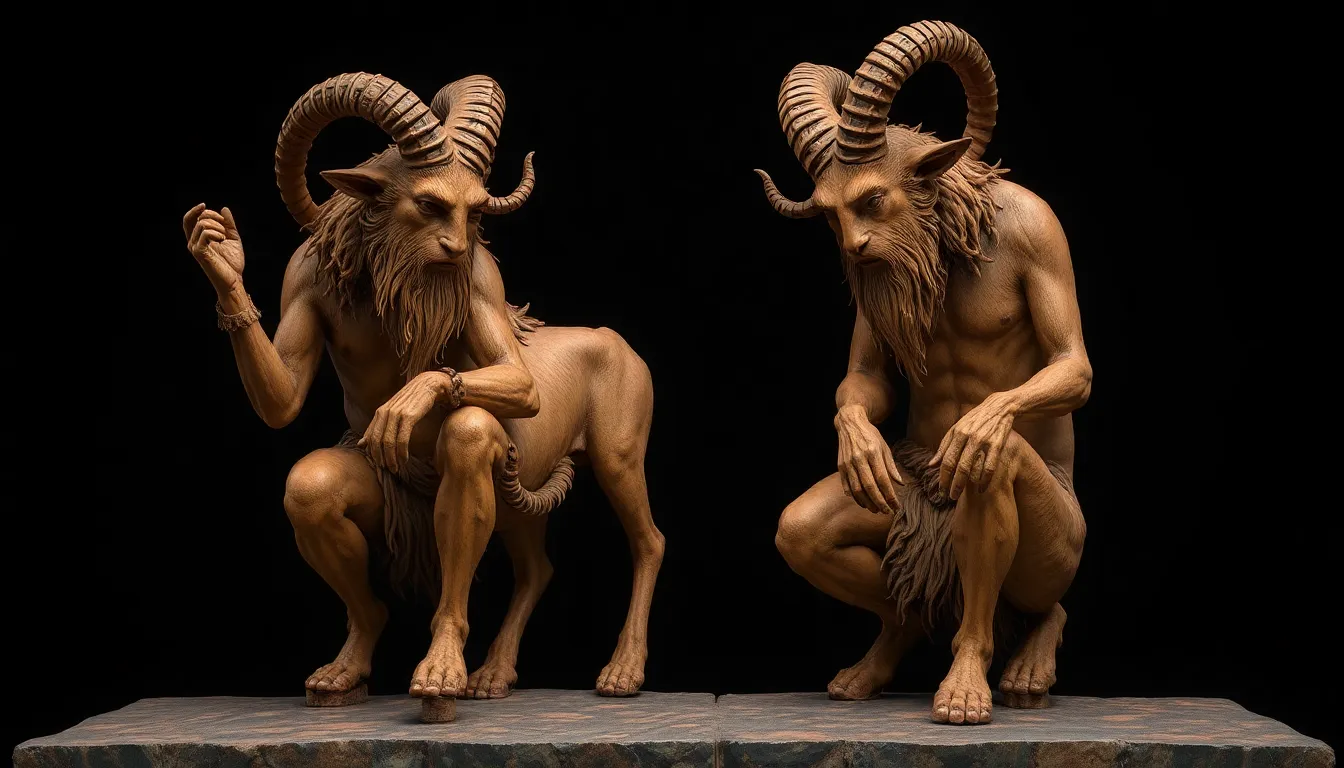Satyrs and Their Impact on Folklore: Regional Variations and Stories
I. Introduction
Satyrs are fascinating creatures from mythology, often depicted as half-human and half-goat beings known for their love of music, dance, and revelry. In Greek mythology, they are closely associated with Dionysus, the god of wine and ecstasy, embodying the wildness and untamed aspects of nature.
The significance of satyrs extends beyond Greek mythology, as they have permeated various cultural folklore around the world, each region adding its unique twist to the satyr narrative. This article will explore the historical origins of satyrs, their depictions in European, Asian, and African folklore, contemporary interpretations, and their role in environmental narratives.
II. Historical Origins of Satyrs
A. Roots in Greek mythology
In Greek mythology, satyrs are often depicted as companions of Dionysus, engaging in wild celebrations and embodying the spirit of nature. Their characteristics include:
- Human-like upper bodies with goat-like legs and features.
- Playful, mischievous behavior often leading to drunken revelry.
- A love for music, frequently portrayed playing instruments like the flute or lyre.
Satyrs symbolize fertility, nature’s bounty, and the primal aspects of human existence.
B. Evolution of satyr figures in ancient cultures
As cultures evolved, the image of satyrs transformed, influenced by local beliefs and practices. They began appearing in Roman mythology, often merging with similar nature spirits, and their representation shifted towards more playful and less serious interpretations.
III. Satyrs in European Folklore
A. Variations in depiction across countries
In European folklore, satyrs have taken on various forms and meanings:
- Greek and Roman interpretations: In these cultures, satyrs retained their connection to Dionysian revelry, often depicted as carefree spirits.
- Celtic influences in Britain and Ireland: Here, they are often conflated with faeries or other woodland spirits, embodying both mischief and protection of nature.
B. Prominent stories and legends featuring satyrs
Satyrs play a crucial role in several European fairy tales, often representing the struggle between civilization and nature. They appear in stories that highlight their playful nature and connection to the wild. Notable influences include:
- The role of satyrs in European fairy tales: Many tales feature satyr-like characters who assist or hinder protagonists, emphasizing the unpredictability of nature.
- Influence on modern literature: Contemporary works often draw from satyr folklore, portraying them as complex characters that balance humanity with primal instincts.
IV. Satyrs in Asian Folklore
A. Comparison with similar figures in Asian mythology
In Asian cultures, similar figures to satyrs can be found, often representing nature spirits and fertility deities:
- Connections to nature spirits in Hinduism and Buddhism: Figures like the Vata in Hinduism share similarities with satyrs, embodying the spirit of the forest.
- Folkloric parallels in Chinese and Japanese traditions: Creatures like Shōjō in Japan are known for their wild hair and connection to music and nature.
B. Notable stories and their cultural significance
In these traditions, stories of satyr-like beings often emphasize the importance of harmony with nature and the consequences of excess. These narratives serve to educate and instill respect for the natural world.
V. Satyrs in African Folklore
A. Indigenous interpretations and regional variations
In Africa, satyr-like creatures manifest through various indigenous myths, often embodying themes of fertility, nature, and community.
- The role of satyr-like creatures in African myths: These beings often act as mediators between humans and nature, highlighting the importance of ecological balance.
- Symbolism of fertility and nature: Many African cultures view these creatures as symbols of prosperity, associated with agricultural cycles and fertility rites.
B. Impact of colonialism on the portrayal of satyrs
Colonial narratives often distorted indigenous depictions of satyr-like beings, framing them within European paradigms. This has led to a loss of original meanings and a blending of cultural identities.
VI. Contemporary Interpretations of Satyrs
A. Modern literature and media representations
In contemporary culture, satyrs have experienced a resurgence in popularity, appearing in various media forms:
- Satyrs in fantasy novels and films: From J.K. Rowling’s Harry Potter series to Rick Riordan’s Percy Jackson books, satyrs are depicted as humorous, loyal, and deeply connected to nature.
- The resurgence of interest in folklore: Modern storytelling often revisits these ancient figures, bringing them into new contexts that resonate with current environmental concerns.
B. Influence on popular culture and art
Satyrs have also influenced visual arts, inspiring countless paintings, sculptures, and performances that highlight their playful and chaotic nature.
VII. The Role of Satyrs in Environmental Folklore
A. Symbolism of satyrs as guardians of nature
Satyrs are often viewed as guardians of the natural world, representing the balance between humanity and nature. Their narratives frequently emphasize the importance of living harmoniously with the environment.
B. Folkloric narratives promoting environmental awareness
Many stories featuring satyrs highlight themes of conservation and respect for nature, illustrating the consequences of neglecting the natural world.
C. Regional stories that highlight ecological themes
Across cultures, satyrs are involved in tales that promote sustainable practices, encouraging communities to cherish and protect their natural surroundings.
VIII. Conclusion
In conclusion, satyrs play a multifaceted role in folklore, embodying the complexities of nature, humanity, and the balance between the two. Their enduring legacy across various cultures highlights their cultural significance and the lessons embedded in their stories.
As we explore and preserve these regional narratives, we can gain a deeper understanding of the values and beliefs that shape our relationship with the natural world. Satyrs remind us of the wildness within and the importance of celebrating and protecting our environment.




